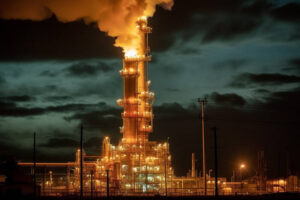LNG Exports Hold Steady Amid Mixed Demand Landscape
In the ever-evolving landscape of the U.S. natural gas market, liquefied natural gas (LNG) exports have demonstrated remarkable resilience, reaching 16.3 billion cubic feet per day (Bcf/d) as of last Friday. This marks a 9.1% increase compared to the previous week, providing vital support to prices. It’s crucial for investors to pay close attention to these trends as they navigate a market marked by uncertainty and volatility.
A Deeper Dive into LNG Exports
At Extreme Investor Network, we believe that understanding these fluctuations is key for strategic investment decisions. The current projections from BloombergNEF indicate that U.S. storage levels may be 10% below the five-year average by summer. This prospect keeps bullish market positioning alive, even as other indicators paint a more subdued picture. For our community of investors, this insight underscores how dynamic external conditions can influence stock prices within the energy sector.
Storage Levels and Supply Dynamics
Recent data from the EIA reveals a +57 Bcf injection for the week ending April 4, which, while in line with expectations, significantly surpasses the five-year average injection of +17 Bcf for this period. Currently, storage levels sit 2.1% below the five-year average and a stark 19.8% below last year’s levels. This signals a tight supply landscape that could spark market activity. While dry gas production remains steady at 106.2 Bcf/d—a 4.7% year-over-year increase—the actual demand at 76.7 Bcf/d reflects a gradual uptick of 11.4% year-over-year. This juxtaposition of strong production and moderate demand is where seasoned investors may spot opportunities.
Weather Patterns and Rig Counts: A Dual Influence
While the current injection numbers paint a somewhat bullish scenario, mixed weather conditions and a slight uptick in rig counts continue to exert pressure on market expectations. According to the Commodity Weather Group, the forecast from April 16 to 20 anticipates above-normal temperatures in the West with more typical seasonal weather in other regions. This could limit any late-season heating demand, further complicating the picture for natural gas prices.
Moreover, Baker Hughes reports a modest increase of one rig, raising the total to 97 gas rigs—still historically low, yet indicative of a possible market shift. As we move forward, keeping an eye on these external factors will be crucial for modeling potential price changes.
Navigating a Slightly Bearish Market Forecast
At Extreme Investor Network, we are committed to arming our readers with the most pertinent information. As we assess the current market dynamics, it appears that natural gas faces a slightly bearish bias in the near term. Trade tensions clouding demand forecasts coupled with weak weather indicators leave nat-gas vulnerable to potential downside. Although LNG flows and tight storage are bullish anchors for the market, absent a weather change or robust export surge, we might see further drift in prices.
For our dedicated investors, this presents a moment to reflect on the broader implications of such data. Understanding the interplay between weather patterns, supply levels, and market sentiment can provide a competitive edge in navigating uncertainties.
Stay Informed with Our Economic Calendar
To remain ahead in the game, ensure you’re leveraging all the resources at your disposal. Our Economic Calendar offers vital updates and predictions that can sharpen your investment insights. Join the Extreme Investor Network community today and empower your investment journey with knowledge and strategies tailored for success in today’s complex market landscape!

